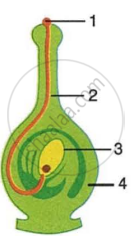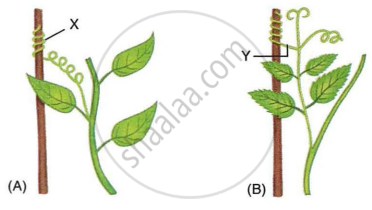Advertisements
Advertisements
प्रश्न
How are tropic movements helpful to plants? Explain with an example.
उत्तर
Tropic movements are helpful in the growth of plants.
Phototropism is an example of tropic movements. The stems of plants respond to sunlight by growing towards it. The plants also turn their leaves to face the sun. This enables their leaves to get as much sunlight as possible that is required for photosynthesis.
APPEARS IN
संबंधित प्रश्न
Give one example of chemotropism. State whether this example is of positive chemotropism or negative chemotropism.
To which directional stimuli do shoots respond?
Plant roots grow ______ and in the direction of force of ______.
What is meant by 'tropisms' (or tropic movements)? Explain with an example.
Which of the following acts as a stimulus in the process of hydrotropism?
(a) hydrocarbon
(b) hydrogen oxide
(c) hydrogen chloride
(d) hydrogen peroxide
A potted plant is growing in a transparent glass jar. In this plant, X and Y are the two growing parts having a lot of meristematic tissue. It is observed that the part X of this plant exhibits positive geotropism but negative phototropism. On the other hand, part Y of this plant exhibits negative geotropism but positive phototropism.
(a) Name the part X of plant.
(b) Name the part Y of plant.
(c) Which part of the plant, X or Y, will exhibit positive hydrotropism?
(d) Which part of the plant, X or Y, can have tendrils on it?
(e) Which phytohormone causes the part X to exhibit negative phototropism?
When the leaves of a sensitive plant are touched with a finger, they fold up and when light fades at dusk, the petals of a dandelion flower close.
State one way in which the above two processes are similar.
Why do roots of halophytes show negative geotropism?
The diagram given alongside shows a type of tropism. Study the same and answer the questions that follow:

- Name and define the type of tropism shown in the diagram.
- Label the guidelines (1) to (4).
- Name two effective stimulants that help in the growth of part (2).
- Name two groups of plants where part (2) grows towards gametophyte with the help of the stimulants mentioned in (c).
Study the diagrams given below and answer the following questions:

- Name the structures shown as X and Y in the figures (A) and (B), respectively.
- Write the functions performed by the structures X and Y.
- Name the phenomenon depicted and define it.
- How do the structures X and Y differ from each other?
- Give examples of the plants which show the said phenomenon.
